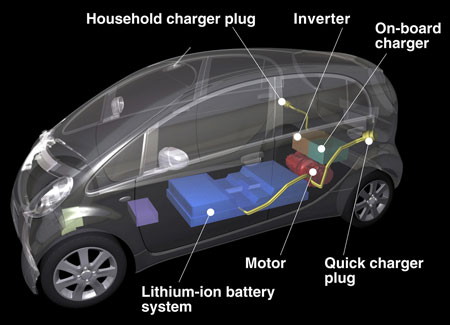This is an extension form my previous post about Idea for Selling Electric Cars
I got this idea while watching a youtube video of a test drive of the Nissan Leaf - a really hot up-and-coming electric car.
Premise : Source
Instead of focusing on what comes out, let's focus on what goes in. In a fuel-powered car, we're using a chemical energy source which is fixed - within a given range of parameters, there's only one type of fuel we can use. This creates source dependence. At any given time, even if you have an abundance of energy in other forms, you'll still need to go to a gas station to power this so-useful machine. That sucks!
What sets the electric vehicle apart:
The electric vehicle gives source independence. You can convert just about any source of energy into electricity and store it in the electric vehicle's batteries.
ANY source : Solar, wind, nuclear, thermal, hydro, chemical (fuel cell), and.. mechanical!
So why don't we use this to add an accessory to the car that turns humans or anything around into an energy source? Consider a scenario : when the grid power has failed, or if the car is in a place with no grid power nearby for charging. We have an opportunity here to free the mobile vehicle from grid dependency.
Idea : With the electric car, keep a portable dynamo in the boot. Just a small coil generator with a standard shaft. Then a couple of tools to connect this to something like a bicycle pedal, or anything that rotates. A power cord coming out of the dynamo then goes into the car's plug-in.
That brings me to a design recommendation. The electric vehicle's battery is DC - direct current. I haven't been able to find what's the exact charging voltage for it, but it's got to be under 30V DC.
From the data on the electric cars in development today (sample: Nissan Leaf), they're designing the charging systems to plug into standard AC - alternating current - grid supply.
The assumption is that only AC power will be available. The car will internally convert this into DC and feed it into the battery. I hate assumptions!
My recommendation : Keep an additional port , or switch, to take in lower-volltage DC power for charging. This is what will make the car independent of the grid : We know that most off-grid power generation is typically lower-voltage DC. Solar, small-scale wind, fuel cell, DYNAMO....
get it?
From a design perspective, this would be damn easy. Actually, easier than having the typical AC plug-in. Because you just need to take out a line from the DC side of the AC-DC converter and bring it to a port outside. Or whatever!
These small changes will give electric car owners an immense degree of independence from centralized networks. Its importance in the event of a disaster will be immeasurable : One could set up a makeshift windmill, or even an exercise cycle, connect the rotating shaft to the portable dynamo and use it to recharge the car batteries. Time required wouldn't be important here - the stranded people could just wait half a day and then drive to the nearest safe location.
Another Idea : With DC charging, we could keep folding solar panels on top... Even if they make little, if kept out in the sun for an entire day, it would be good enough for a short trip! Or, if someone's out of town a few days, keep the car in the sun would prevent it from discharging. (maybe! just brainstorming concepts here..)
Do you have any more ideas that could go here?


2 comments:
This is a good concept that i'm sure many have thought of using before, but it comes down to (as always) transport infrastructure. Once the car is revolutionised the whole network will have to play catch up. I think the best angle is not to think when in the the future but to think now and design around that in terms of transport design.
Post a Comment